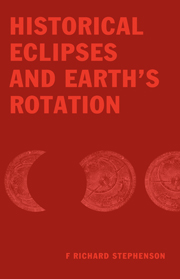Book contents
- Frontmatter
- Contents
- Principal Symbols
- 1 Variations in the length of the day: a historical perspective
- 2 Tidal friction and the ephemerides of the Sun and Moon
- 3 Pre-telescopic eclipse observations and their analysis
- 4 Babylonian and Assyrian records of eclipses
- 5 Investigation of Babylonian observations of solar eclipses
- 6 Timed Babylonian lunar eclipses
- 7 Untimed Babylonian observations of lunar eclipses: horizon phenomena
- 8 Chinese and other East Asian observations of large solar eclipses
- 9 Other East Asian observations of solar and lunar eclipses
- 10 Records of eclipses in ancient European history
- 11 Eclipse records from medieval Europe
- 12 Solar and lunar eclipses recorded in medieval Arab chronicles
- 13 Observations of eclipses by medieval Arab astronomers
- 14 Determination of changes in the length of the day
- Appendix A Timed data
- Appendix B Untimed data
- References
- Acknowledgements
- Index of eclipse records
- Index of places of observation
- Name Index
- Subject index
3 - Pre-telescopic eclipse observations and their analysis
Published online by Cambridge University Press: 13 November 2009
- Frontmatter
- Contents
- Principal Symbols
- 1 Variations in the length of the day: a historical perspective
- 2 Tidal friction and the ephemerides of the Sun and Moon
- 3 Pre-telescopic eclipse observations and their analysis
- 4 Babylonian and Assyrian records of eclipses
- 5 Investigation of Babylonian observations of solar eclipses
- 6 Timed Babylonian lunar eclipses
- 7 Untimed Babylonian observations of lunar eclipses: horizon phenomena
- 8 Chinese and other East Asian observations of large solar eclipses
- 9 Other East Asian observations of solar and lunar eclipses
- 10 Records of eclipses in ancient European history
- 11 Eclipse records from medieval Europe
- 12 Solar and lunar eclipses recorded in medieval Arab chronicles
- 13 Observations of eclipses by medieval Arab astronomers
- 14 Determination of changes in the length of the day
- Appendix A Timed data
- Appendix B Untimed data
- References
- Acknowledgements
- Index of eclipse records
- Index of places of observation
- Name Index
- Subject index
Summary
Introduction
Despite their relatively low precision, pre-telescopic observations cover a sufficient time-span for long-term trends in the length of day (LOD) to become apparent. These trends cannot be discerned from modern measurements. Here we have the main reason why archaic observations are so important in the study of the Earth's past rotation.
The analysis of ancient and medieval eclipse records is just one of several techniques which have been utilised in recent years to investigate variations in the LOD over the historical past. Before discussing in detail the application of eclipse observations to this problem, it is necessary to briefly consider other available methods and to explain why eclipses are to be preferred to other types of data.
Observational requirements for determining Δ T in the pre-telescopic period
Any early astronomical observation which is of value in studying changes in the LOD in the past must satisfy a wide variety of criteria. These may be listed as follows:
(i) The observation must involve at least one of the brighter and more rapidly moving objects in the solar system (i.e. the Moon, Sun or one of the inner planets Mercury, Venus and Mars).
(ii) The exact Julian or Gregorian date of the observation must either be specified directly or be able to be determined unambiguously.
[…]
- Type
- Chapter
- Information
- Historical Eclipses and Earth's Rotation , pp. 43 - 92Publisher: Cambridge University PressPrint publication year: 1997



